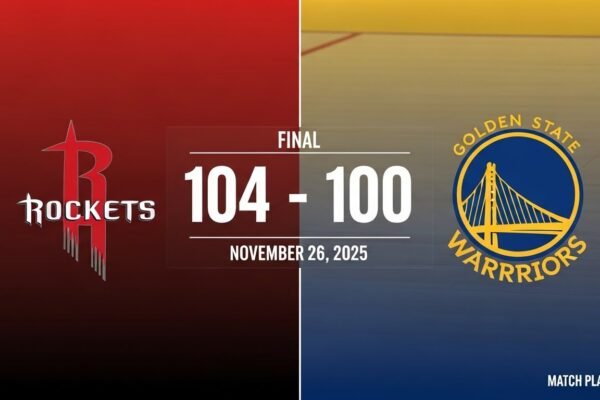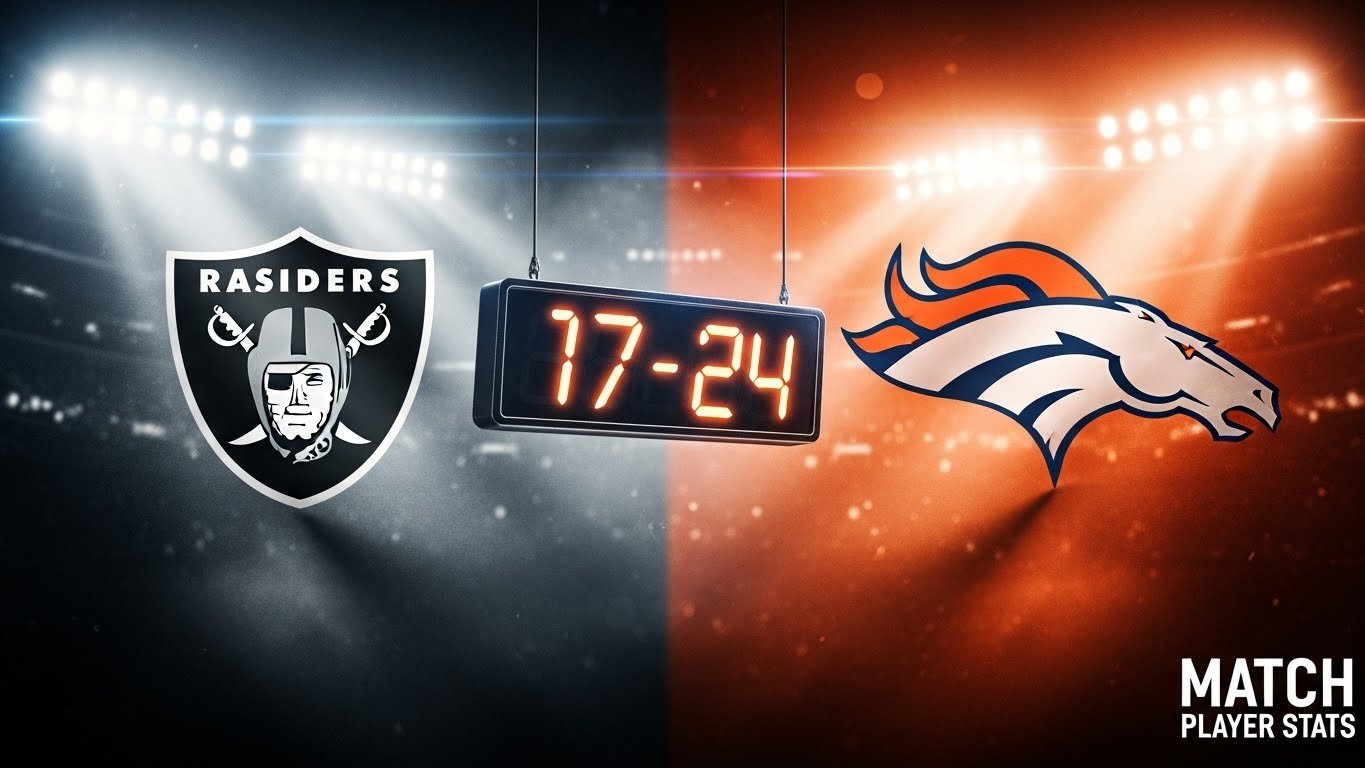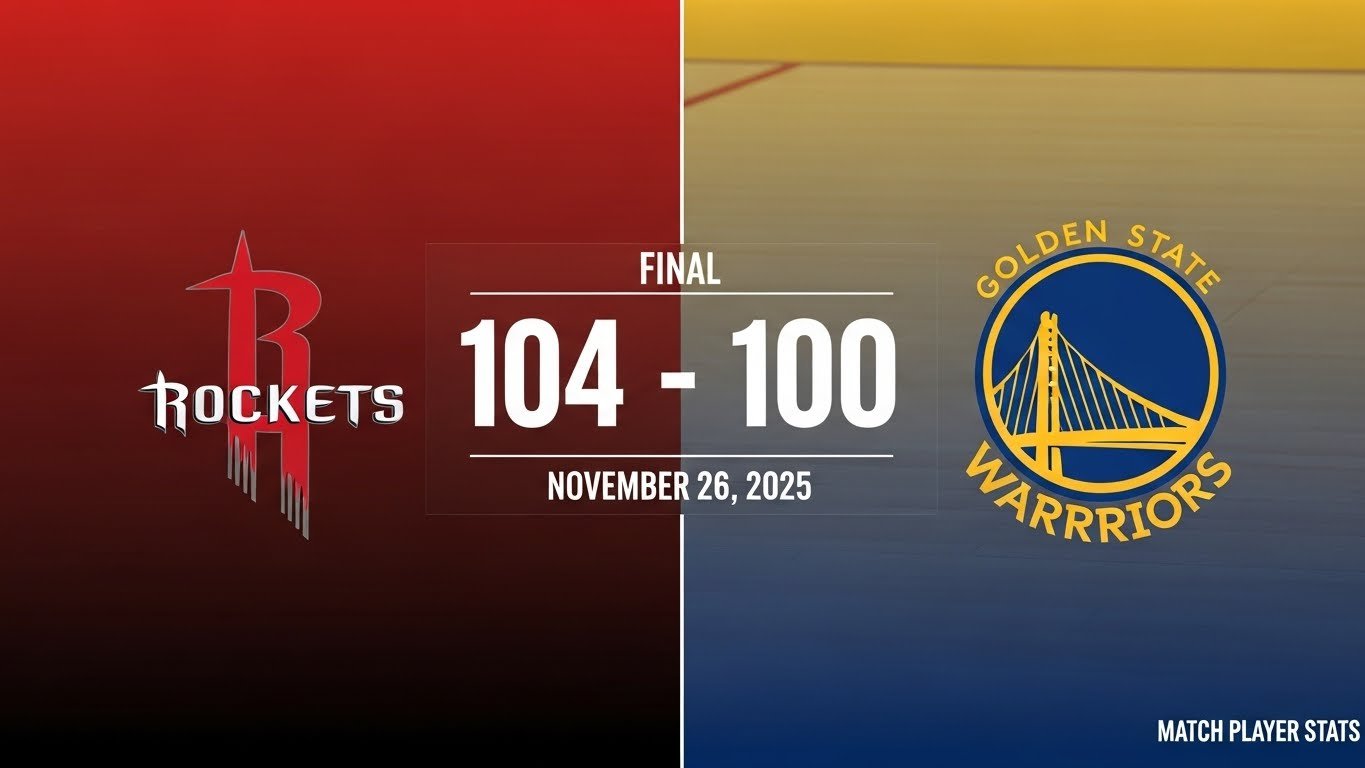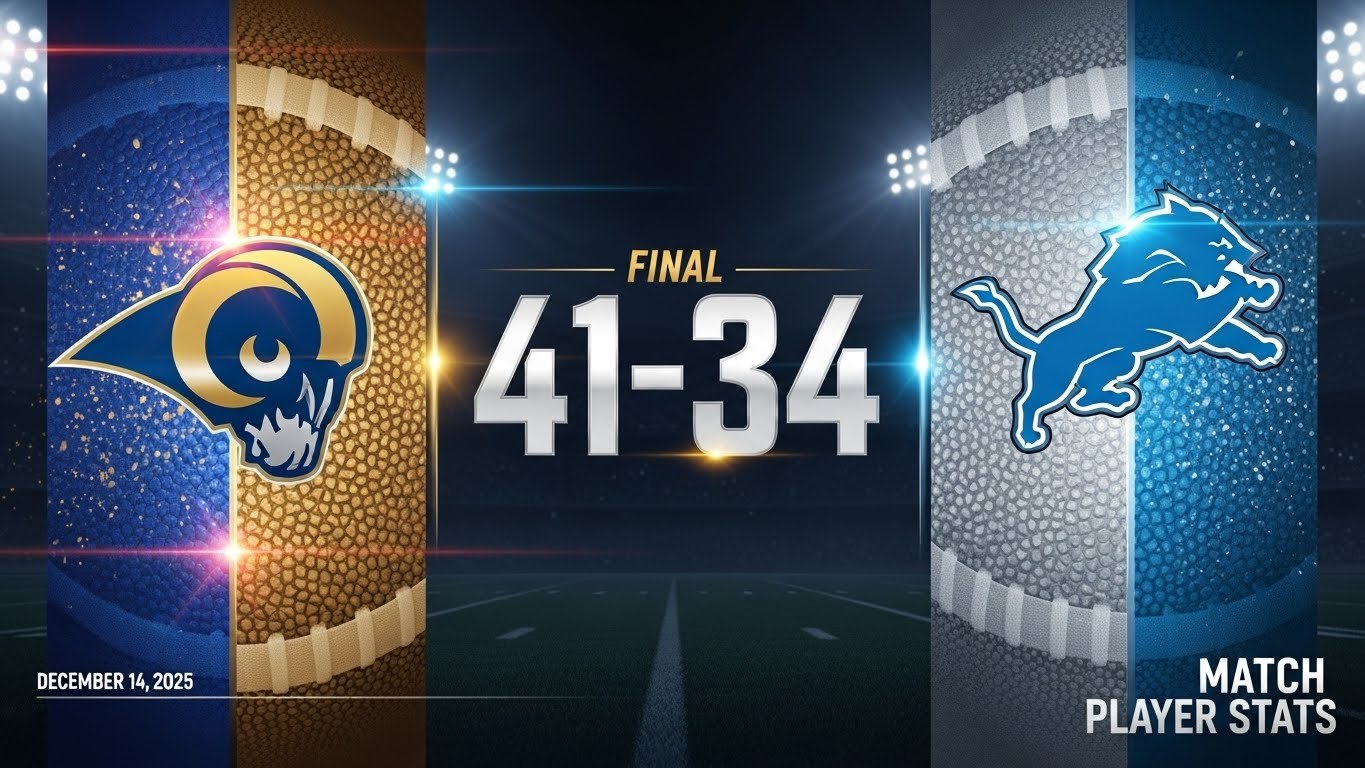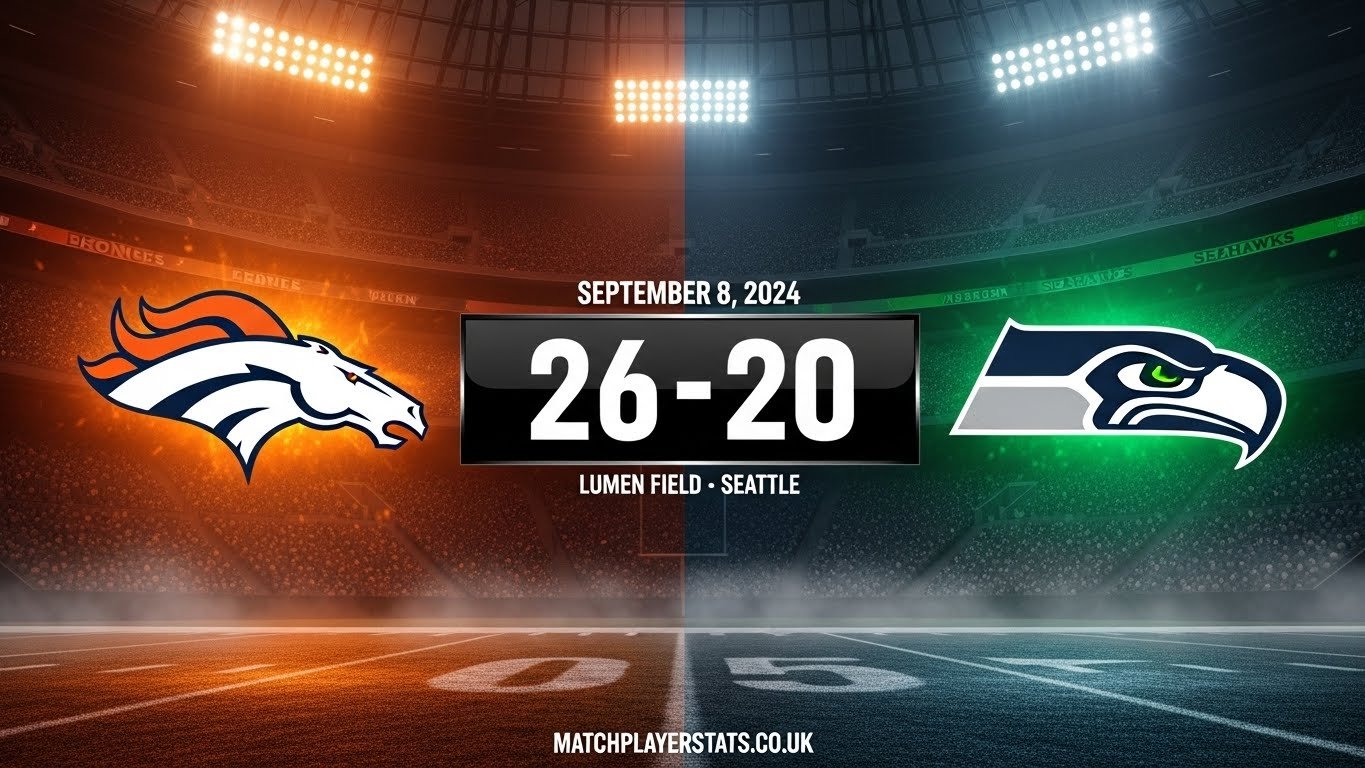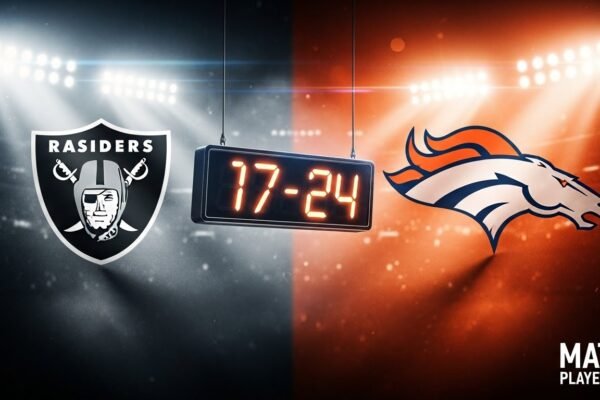
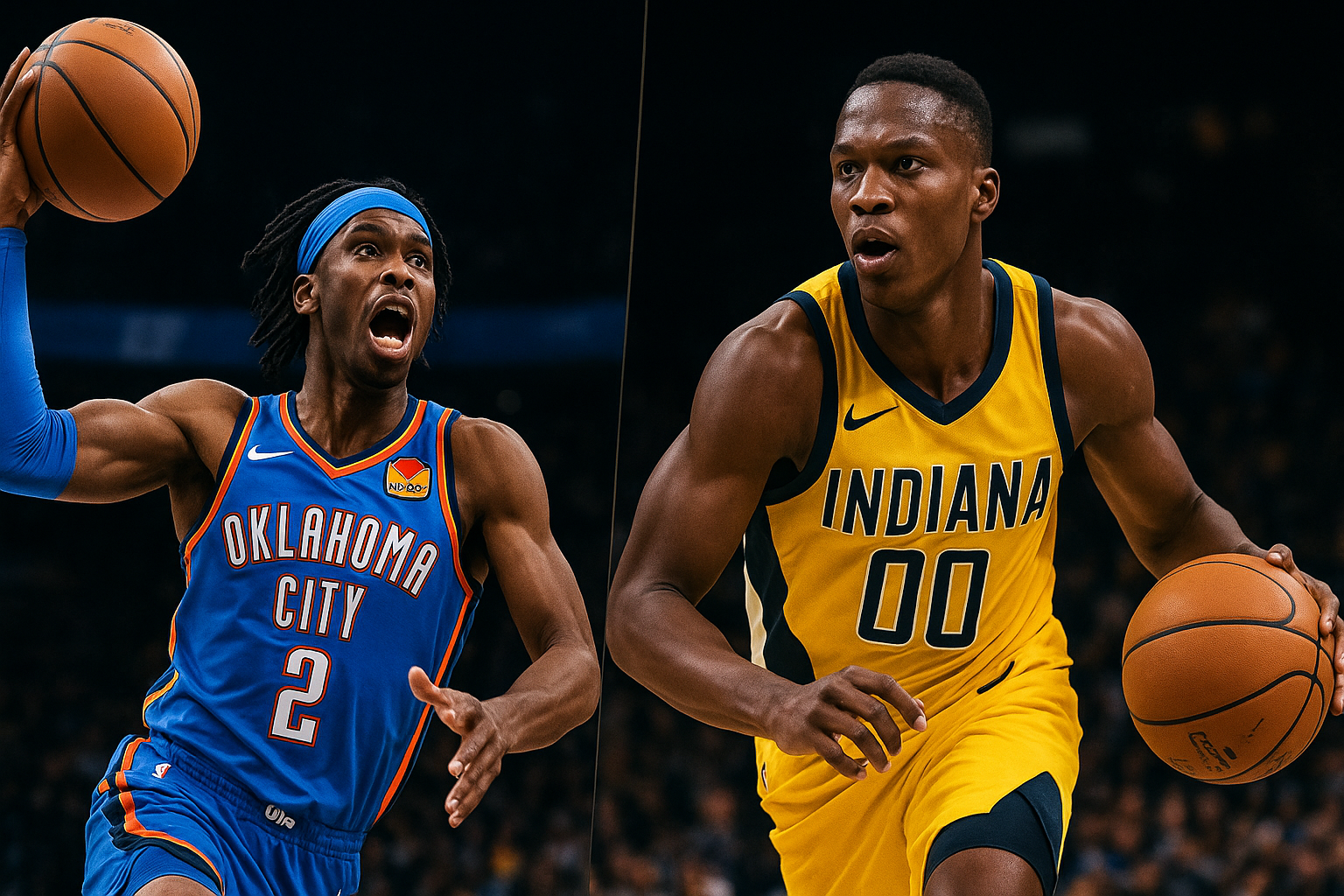
Oklahoma City Thunder vs Indiana Pacers Match Player Stats (Oct 23, 2025)
The Oklahoma City Thunder vs Indiana Pacers match player stats from October 23, 2025, belong in a time capsule. Shai Gilgeous-Alexander exploded for a career-high 55 points as the defending champions outlasted Indiana 141-135 in double overtime at Gainbridge Fieldhouse. This NBA Finals rematch delivered 58 minutes of back-and-forth basketball that featured 70 fouls, three players fouling out, and the Thunder making history as the first team ever to open a season with consecutive double overtime victories.
Table of Contents
Complete Box Scores and Game Leaders
Oklahoma City Thunder 141, Indiana Pacers 135 (2OT)
October 23, 2025 | Gainbridge Fieldhouse | Attendance: 17,274
Game Leaders
| Category | Thunder | Pacers |
|---|---|---|
| Points | S. Gilgeous-Alexander 55 | B. Mathurin 36 |
| Rebounds | I. Hartenstein 14 | P. Siakam 15 |
| Assists | S. Gilgeous-Alexander 5 | P. Siakam, B. Sheppard 4 |
Oklahoma City Thunder Starters
| Player | MIN | PTS | REB | AST | FG | 3PT | FT | STL | BLK | TO | +/- |
|---|---|---|---|---|---|---|---|---|---|---|---|
| S. Gilgeous-Alexander | 45:21 | 55 | 8 | 5 | 15-31 | 2-7 | 23-26 | 2 | 1 | 2 | +9 |
| A. Wiggins | 35:45 | 23 | 9 | 0 | 7-14 | 5-9 | 4-4 | 0 | 1 | 1 | +8 |
| C. Holmgren | 38:57 | 15 | 12 | 2 | 4-12 | 0-6 | 7-8 | 2 | 0 | 3 | +1 |
| I. Hartenstein | 36:54 | 5 | 14 | 2 | 2-4 | 0-0 | 1-3 | 0 | 0 | 2 | +6 |
| L. Dort | 43:26 | 7 | 8 | 2 | 2-6 | 1-4 | 2-2 | 1 | 0 | 3 | +1 |
Oklahoma City Thunder Bench
| Player | MIN | PTS | REB | AST | FG | 3PT | FT | STL | BLK | TO | +/- |
|---|---|---|---|---|---|---|---|---|---|---|---|
| A. Mitchell | 38:07 | 26 | 3 | 4 | 9-19 | 0-3 | 8-8 | 1 | 0 | 1 | +12 |
| J. Williams | 14:31 | 5 | 2 | 2 | 2-3 | 1-2 | 0-0 | 0 | 0 | 2 | -9 |
| B. Barnhizer | 14:15 | 2 | 3 | 0 | 1-2 | 0-0 | 0-0 | 0 | 0 | 0 | -6 |
| O. Dieng | 15:19 | 0 | 1 | 0 | 0-3 | 0-3 | 0-0 | 0 | 0 | 0 | -1 |
| C. Youngblood | 6:19 | 3 | 0 | 0 | 1-1 | 1-1 | 0-0 | 0 | 0 | 0 | +8 |
| B. Carlson | 1:06 | 0 | 0 | 0 | 0-0 | 0-0 | 0-0 | 0 | 0 | 0 | +1 |
Indiana Pacers Starters
| Player | MIN | PTS | REB | AST | FG | 3PT | FT | STL | BLK | TO | +/- |
|---|---|---|---|---|---|---|---|---|---|---|---|
| B. Mathurin | 45:07 | 36 | 11 | 1 | 9-19 | 3-8 | 15-17 | 0 | 0 | 4 | +9 |
| P. Siakam | 44:06 | 32 | 15 | 4 | 12-25 | 3-6 | 5-12 | 1 | 0 | 1 | -8 |
| A. Nesmith | 26:46 | 5 | 7 | 0 | 2-7 | 1-3 | 0-0 | 0 | 0 | 1 | -4 |
| A. Nembhard | 16:52 | 4 | 1 | 4 | 0-5 | 0-2 | 4-4 | 0 | 0 | 2 | -3 |
| I. Jackson | 8:29 | 0 | 1 | 0 | 0-2 | 0-0 | 0-0 | 0 | 0 | 2 | +2 |
Indiana Pacers Bench
| Player | MIN | PTS | REB | AST | FG | 3PT | FT | STL | BLK | TO | +/- |
|---|---|---|---|---|---|---|---|---|---|---|---|
| O. Toppin | 39:58 | 20 | 5 | 3 | 8-18 | 0-8 | 4-4 | 2 | 0 | 1 | -2 |
| B. Sheppard | 39:03 | 15 | 8 | 4 | 5-11 | 3-7 | 2-2 | 1 | 1 | 0 | -5 |
| J. Walker | 30:19 | 13 | 4 | 4 | 6-11 | 1-5 | 0-0 | 1 | 0 | 2 | -7 |
| J. Huff | 11:49 | 5 | 3 | 0 | 2-4 | 1-2 | 0-0 | 0 | 2 | 0 | +6 |
| T. Peter | 16:37 | 3 | 0 | 1 | 1-2 | 1-2 | 0-0 | 1 | 0 | 1 | -7 |
| T. Bradley | 9:55 | 2 | 0 | 0 | 1-1 | 0-0 | 0-1 | 0 | 1 | 0 | -9 |
| J. Furphy | 0:59 | 0 | 0 | 0 | 0-0 | 0-0 | 0-0 | 0 | 0 | 0 | -2 |
Team Comparison
| Category | Thunder | Pacers |
|---|---|---|
| Field Goals | 43-95 (45.3%) | 46-105 (43.8%) |
| Three Pointers | 10-35 (28.6%) | 13-43 (30.2%) |
| Free Throws | 45-51 (88.2%) | 30-40 (75.0%) |
| Rebounds | 60 | 55 |
| Assists | 17 | 21 |
| Turnovers | 14 | 14 |
| Steals | 6 | 6 |
| Blocks | 2 | 4 |
| Personal Fouls | 33 | 37 |
| Pace | 100.9 | 100.9 |
How This Marathon Unfolded
Neither team led by more than seven points across 58 minutes of physical basketball. The game featured 18 lead changes and 19 ties before Oklahoma City finally broke through in the second overtime.
Score By Period
| Quarter | Thunder | Pacers | Lead |
|---|---|---|---|
| 1st | 22 | 25 | IND +3 |
| 2nd | 32 | 22 | OKC +7 |
| 3rd | 27 | 31 | OKC +3 |
| 4th | 32 | 35 | Tied 113 |
| OT | 11 | 11 | Tied 124 |
| 2OT | 17 | 11 | OKC +6 |
Key Momentum Swings
The second quarter swung momentum to Oklahoma City. A 10-0 run orchestrated by Gilgeous-Alexander built the game’s first substantial lead at seven points. The run started at 8:29 with Nembhard pushing Indiana’s lead to four, then the Thunder reeled off ten straight points behind four points and two assists from their MVP.
Indiana clawed back in the third quarter with a 12-2 run spanning just under three minutes. Mathurin triggered the surge with a three-point play at 5:41, giving the Pacers their first lead of the second half at 71-70. Toppin’s three-pointer at 5:00 pushed it to 74-68 before Oklahoma City steadied.
The fourth quarter turned into a slugfest with neither team able to grab control. Chet Holmgren’s two free throws put the Thunder ahead 112-111 with 1:14 remaining. Pascal Siakam answered with a pull-up jumper with 6.5 seconds left, tying it at 113 and forcing overtime.
Indiana opened the first extra period with a 5-0 run. The Thunder entered this game having already survived a double overtime battle against Houston two nights earlier, and the fatigue showed early in the extra session. But Oklahoma City responded with free throws, as Gilgeous-Alexander continued drawing fouls at will. His step-back jumper with 27.1 seconds left gave the Thunder a two-point cushion at 124-122, but Mathurin drove baseline and finished at the rim with 12 seconds remaining to tie it at 124.
The second overtime belonged to Aaron Wiggins. His back-to-back three-pointers at 4:51 and 4:04 pushed Oklahoma City ahead 135-128 with 2:06 remaining. Indiana, playing without three rotation players who fouled out, couldn’t generate quality looks down the stretch.
The Free Throw Line Won This Game
Strip away everything else and one stat explains the outcome. Oklahoma City dominated at the stripe.
| Category | Thunder | Pacers | Difference |
|---|---|---|---|
| FT Made | 45 | 30 | +15 |
| FT Attempted | 51 | 40 | +11 |
| FT Percentage | 88.2% | 75.0% | +13.2% |
That 15-point advantage from the charity stripe more than accounts for the six-point final margin. Oklahoma City’s strategy was surgical: attack the basket, force contact, make officials blow the whistle. The approach worked to perfection.
The Thunder attempted a free throw on 53.7% of their field goal attempts. Indiana managed just 41.4%. Gilgeous-Alexander alone went to the line 26 times, converting 23. That’s more attempts than Indiana’s entire starting lineup combined.
The constant whistles created controversy throughout. Officials called 70 personal fouls on the players plus a technical on Pacers coach Rick Carlisle in the first half. The most contentious sequence came with 2:30 left in the second overtime. Obi Toppin appeared to intercept an inbound pass under the Thunder basket, but officials granted Oklahoma City a timeout just before the steal. Replays showed the call was borderline, and the Gainbridge Fieldhouse crowd erupted. Indiana never recovered momentum after that sequence.
After the game, Carlisle carefully chose his words. “If I talk about the refs, I’m going to get fined an exorbitant amount of money,” he told reporters, according to Sports Illustrated.
The frequent stoppages disrupted Indiana’s preferred pace. Both teams played at 100.9 possessions per 48 minutes, well below Indiana’s season target but necessary given the constant foul calls and free throw parade. Carlisle noted the constant breaks prevented his team from establishing any rhythm, particularly frustrating for a squad built around quick ball movement and transition opportunities.
Gilgeous-Alexander’s Historic Performance
The reigning MVP reached 50 points for the fifth time in his career, tying Russell Westbrook for most by a Thunder player. His 55 points rank as the second-highest total in franchise history behind Westbrook’s 57.
But the raw scoring total only begins to tell the story. Gilgeous-Alexander’s 64.8% true shooting percentage on a usage rate of 43.2% demonstrates elite efficiency while carrying an immense offensive load. Most players see their shooting percentages crater when asked to shoulder that much responsibility.
His offensive rating of 133 led all starters, per Basketball Reference. For context, that means the Thunder scored 133 points per 100 possessions when Gilgeous-Alexander was on the floor.
The 6-foot-6 guard lived in the paint. Of his 55 points, 38 came from drives, free throws, or at-rim finishes. Just 17 points came from mid-range or three-point range. His shot chart revealed a player who understood exactly where his advantages lay.
He scored nine points in the second overtime alone, repeatedly attacking the basket when his team needed buckets most. His 26 free throw attempts and 23 makes both represent career highs. Every time Indiana tried to slow him down with physicality, he earned another trip to the line.
What made the performance special wasn’t just volume. Gilgeous-Alexander controlled the game’s tempo, deciding when to push pace and when to slow down. He picked his spots attacking, drew fouls consistently, and made the simple pass when Indiana sent help defenders.
This continues a scorching start to the season. Through two games, both double overtime marathons, Gilgeous-Alexander is averaging 47.5 points while shooting 63% from the field and 91% from the line.
Clutch Performance (Final 5 Minutes of 2OT)
| Player | PTS | FG | 3PT | FT |
|---|---|---|---|---|
| S. Gilgeous-Alexander | 6 | 0-1 | 0-0 | 6-6 |
| A. Wiggins | 6 | 2-2 | 2-2 | 0-0 |
| B. Mathurin | 0 | 0-0 | 0-0 | Fouled out |
| P. Siakam | 2 | 1-2 | 0-1 | 0-0 |
Indiana’s Valiant But Flawed Effort
Playing without Tyrese Haliburton for the season and losing Andrew Nembhard to a shoulder injury in the first half, Indiana still pushed the defending champions to the brink.
Mathurin’s Career Night
Bennedict Mathurin went for 36 and 11 in his most complete performance as a pro. The 22-year-old attacked relentlessly, getting to the free throw line 17 times and converting 15. Those attempts and makes both represent career highs.
Mathurin’s fourth quarter performance kept Indiana alive. He scored 15 points in the final period, including a crucial three-pointer with 11:32 remaining that cut Oklahoma City’s lead to 85-83. His aggressive drives drew fouls and created open looks for teammates.
In the first overtime, his driving layup with 12 seconds left tied it at 124 and sent the game to a second extra period. But in the second overtime, fatigue and foul trouble caught up. He managed just one field goal attempt before fouling out with 4:11 remaining, removing Indiana’s most consistent offensive threat when they needed him most.
His 68.0% true shooting percentage ranked second among all rotation players, trailing only Aaron Wiggins’ exceptional 73.0% mark.
Siakam’s Mixed Bag
Pascal Siakam grabbed a game-high 15 rebounds to go with his 32 points, his most boards since joining the Pacers. His pull-up jumper with 6.5 seconds left in regulation tied the game at 113 and forced overtime, one of the biggest shots of the night.
But Siakam’s 5-for-12 performance from the free throw line cost Indiana dearly. Those seven missed charity shots loom large in a six-point loss. In a game decided by free throw disparity, a primary scorer shooting 41.7% from the line is unacceptable.
The Toppin Conundrum
Obi Toppin scored 20 points off the bench and played nearly 40 minutes. His willingness to crash the glass and sprint in transition gave Indiana second chances and kept possessions alive. But his 0-for-8 shooting from three-point range represents eight wasted possessions in a game where every possession mattered.
Eight open looks from three, zero makes. That’s the difference between a win and a loss in a six-point game. Each missed triple gave Oklahoma City another chance to push the ball in transition or reset their half-court offense.
Ben Sheppard provided solid minutes before fouling out, finishing with 15 points, 8 rebounds, and 4 assists in 39 minutes. His defensive versatility forced Gilgeous-Alexander into some difficult shots before picking up his sixth foul. Jarace Walker chipped in 13 points and 4 assists while defending multiple positions across 30 minutes.
Thunder Depth Delivers Again
Oklahoma City entered the game missing five rotation players due to injuries: Cason Wallace, Jalen Williams, Alex Caruso, Isaiah Joe, and Kenrich Williams. The remaining players stepped up when needed.
Mitchell’s Breakout
Ajay Mitchell set a career high with 26 points on 9-of-19 shooting. The second-year guard played 38 minutes and was a perfect 8-for-8 from the free throw line. His offensive rating of 123 and team-best plus-12 rating showed his impact extended beyond scoring.
Mitchell’s just one turnover in 38 minutes demonstrated improved decision-making. His four assists created easy baskets for teammates, and his willingness to attack the basket when Indiana’s defense collapsed on Gilgeous-Alexander opened up driving lanes all night.
Coach Mark Daigneault trusted Mitchell with extended minutes in both overtime periods, a sign of confidence in the young guard’s conditioning and mental toughness. Mitchell rewarded that trust by making winning plays when the game hung in the balance.
Mitchell’s growth from Summer League standout to NBA contributor shows the value of Oklahoma City’s player development system. Earlier this year, Mitchell dominated Summer League competition with 24 points against Memphis, displaying the same fearless attacking mentality that carried over to this regular season performance.
Wiggins Steals the Show Late
Aaron Wiggins started in place of Jalen Williams and delivered 23 points with 9 rebounds. His shooting efficiency was elite: 7-of-14 from the field, 5-of-9 from three-point range, and 4-of-4 from the line.
His two three-pointers to open the second overtime broke Indiana’s resistance. The first came off a pick-and-roll with 4:51 remaining, pushing the lead to 132-128. The second arrived 47 seconds later off a drive-and-kick from Gilgeous-Alexander, extending it to 135-128. That seven-point cushion proved insurmountable for a depleted Pacers squad.
Wiggins’ 136 offensive rating topped all players. His 73.0% true shooting percentage reflects shot selection as much as shooting ability. He took smart shots within the offensive flow and never forced anything.
Oklahoma City’s ability to win their second straight double-OT game while shooting 28.6% from three shows championship DNA. The Thunder’s depth and conditioning advantage becomes more apparent in extended contests where role players must contribute meaningful minutes.
Chet Holmgren grabbed 12 rebounds to go with 15 points but struggled shooting the ball. His 0-for-6 performance from three-point range and 4-of-12 overall mark resulted in a 48.3% true shooting percentage. Isaiah Hartenstein controlled the glass with 14 rebounds but scored just 5 points, though his defensive presence altered shots at the rim all night.
The Injury and Foul Trouble Cascade
Andrew Nembhard’s exit in the first half with a sore left shoulder set off a chain reaction that ultimately sank Indiana’s chances.
How Depth Collapsed
Nembhard’s absence after logging just 16:52 forced other players into expanded roles they weren’t prepared for. Ben Sheppard’s minutes jumped to 39. Bennedict Mathurin logged 45. Both eventually fouled out, a direct result of the increased workload and defensive responsibility.
| Player | Fouls | Minutes | Status | Time Fouled Out |
|---|---|---|---|---|
| A. Nesmith | 6 | 26:46 | Fouled out | 4th Quarter |
| B. Mathurin | 6 | 45:07 | Fouled out | 1st OT (4:11) |
| B. Sheppard | 6 | 39:03 | Fouled out | 2nd OT (0:59) |
By the second overtime, Indiana played without three of its best perimeter defenders. The remaining players faced impossible defensive assignments trying to slow Gilgeous-Alexander while avoiding their sixth foul.
The foul trouble wasn’t random. Oklahoma City’s aggressive drives forced officials to make split-second decisions. More often than not, those calls went against Indiana’s defenders who were playing extended minutes and couldn’t maintain defensive discipline while fighting fatigue.
Coach Carlisle rotated through 12 players searching for combinations that could stay on the floor. Taelon Peter made his NBA debut, scoring 3 points with 1 assist and 1 steal in 17 minutes. Jay Huff added 5 points and 2 blocks in his Pacers debut, providing rim protection in short bursts.
These fringe rotation players performed admirably given the circumstances. But asking them to defend Gilgeous-Alexander in crunch time was an impossible task. The MVP sensed the mismatch and attacked accordingly.
Oklahoma City’s bench outscored Indiana’s reserves 36-38, but the efficiency gap told the real story. Mitchell’s +12 and Wiggins’ +8 provided a stark contrast to the Pacers’ bench struggles. The Thunder’s ability to maintain defensive intensity with second-unit players has become a hallmark of their championship roster construction.
Advanced Metrics Tell The Full Story
The Four Factors, which measure the key statistical areas most correlated with winning, reveal why Oklahoma City controlled the critical moments despite the tight score.
Four Factors Breakdown
| Metric | Thunder | Pacers | Advantage |
|---|---|---|---|
| Effective FG% | 50.5% | 49.0% | OKC +1.5% |
| Turnover % | 10.7% | 10.2% | IND +0.5% |
| Offensive Reb % | 17.0% | 17.7% | IND +0.7% |
| Free Throw Rate | 0.537 | 0.414 | OKC +0.123 |
The free throw rate disparity of 0.123 is massive. Both teams shot similarly from the field. Both protected the ball well. The offensive rebounding battle was essentially even. But the ability to get to the line repeatedly gave the Thunder an insurmountable edge.
Efficiency Ratings
Aaron Wiggins’ 136 offensive rating stands out. Every 100 possessions he was involved in produced 136 points worth of value. His 73.0% true shooting percentage ranked best among all rotation players.
Gilgeous-Alexander’s combination of volume and efficiency is rare. A 43.2% usage rate typically kills efficiency. He maintained elite true shooting despite touching the ball on nearly half of Oklahoma City’s possessions.
Three-Point Shooting Comparison
Neither team shot well from distance, but Oklahoma City’s poor shooting mattered less because of their free throw advantage.
| Category | Thunder | Pacers | Difference |
|---|---|---|---|
| 3PM | 10 | 13 | -3 |
| 3PA | 35 | 43 | -8 |
| 3P% | 28.6% | 30.2% | -1.6% |
| Points from 3PT | 30 | 39 | -9 |
Indiana made three more threes and scored nine more points from beyond the arc. In most games, that’s enough to win. But those nine points were negated by the 15-point free throw advantage Oklahoma City enjoyed.
The Pacers’ strategy of launching 43 three-point attempts made sense given their personnel and preferred style. But when Toppin goes 0-for-8 and key players can’t buy a make, the strategy falls apart. Chet Holmgren went 0-for-6 for Oklahoma City, contributing to an overall 28.6% team mark.
The contrast in approaches was clear: Indiana tried to win with volume three-point shooting, while Oklahoma City won by attacking the rim and getting to the line. On this night, the more physical, interior-focused approach proved superior.
What Comes Next
Oklahoma City improved to 2-0 after becoming the first team in NBA history to open a season with consecutive double overtime games, per AP News. Winning their second straight double-OT contest while shooting 28.6% from three shows the Thunder can grind out victories when their shots aren’t falling.
Indiana drops to 0-1 after outrebounding Oklahoma City (55-60 despite the loss) and forcing the same number of turnovers (14-14). They lost this game at the free throw line, not on the court. Siakam’s seven missed free throws and Toppin’s eight missed threes represent the 15-point swing that decided the outcome.
The Thunder visit Atlanta on Saturday while the Pacers begin a three-game road trip at Memphis. Both teams will be searching for regulation victories after this exhausting classic.
The Oklahoma City Thunder vs Indiana Pacers match player stats reveal a simple equation: Oklahoma City’s 15-point free throw advantage minus Indiana’s nine-point three-point advantage equals a six-point Thunder win. Gilgeous-Alexander’s 55 points will grab headlines, but the 70 fouls called and three Pacers fouling out decided this double overtime classic.

